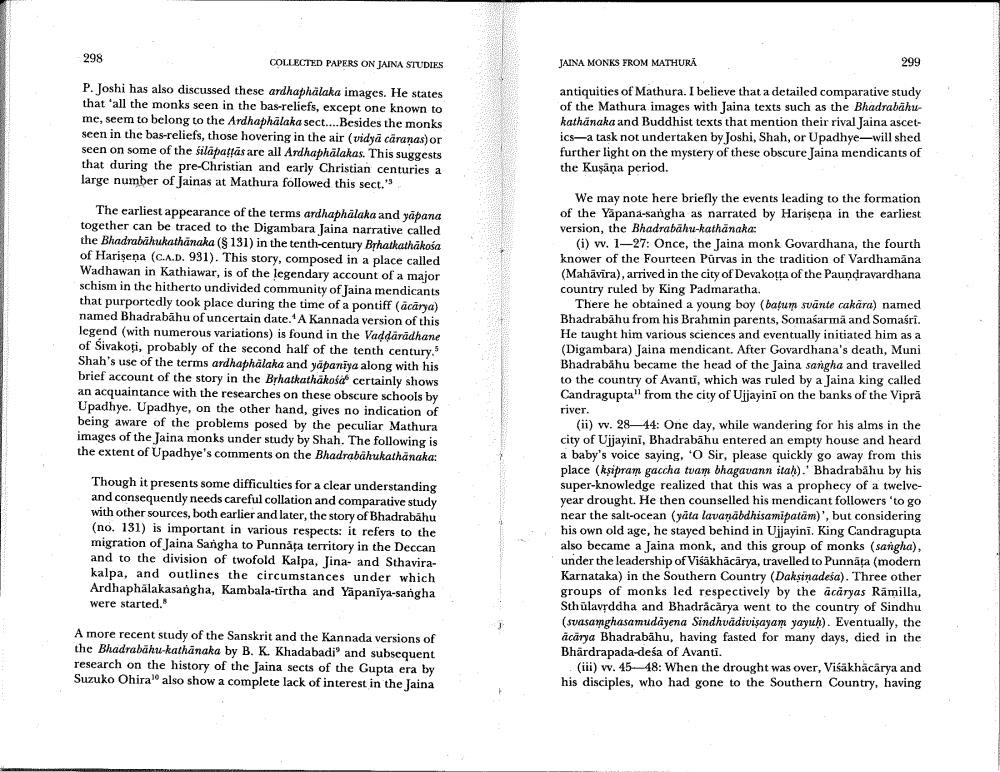________________
298
COLLECTED PAPERS ON JAINA STUDIES
JAINA MONKS FROM MATHURA
299
P. Joshi has also discussed these ardhaphalaka images. He states that 'all the monks seen in the bas-reliefs, except one known to me, seem to belong to the Ardhaphalaka sect....Besides the monks seen in the bas-reliefs, those hovering in the air (vidya caranas)or seen on some of the silapattās are all Ardhaphalakas. This suggests that during the pre-Christian and early Christian centuries a large number of Jainas at Mathura followed this sect."
antiquities of Mathura. I believe that a detailed comparative study of the Mathura images with Jaina texts such as the Bhadrabahukathanaka and Buddhist texts that mention their rival Jaina ascet ics a task not undertaken by Joshi, Shah, or Upadhye-will shed further light on the mystery of these obscure Jaina mendicants of the Kuşåna period.
The earliest appearance of the terms ardhaphalaka and yapana together can be traced to the Digambara Jaina narrative called the Bhadrabahukathanaka ($ 131) in the tenth-century Byhatkathakosa of Harisena (C.A.D. 931). This story, composed in a place called Wadhawan in Kathiawar, is of the legendary account of a major schism in the hitherto undivided community of Jaina mendicants that purportedly took place during the time of a pontiff (acarya) named Bhadrabāhu of uncertain date. A Kannada version of this legend (with numerous variations) is found in the Vaddarddhane of Sivakoti, probably of the second half of the tenth century." Shah's use of the terms ardhaphalaka and yapaniya along with his brief account of the story in the Brhatkathakośd certainly shows an acquaintance with the researches on these obscure schools by Upadhye. Upadhye, on the other hand, gives no indication of being aware of the problems posed by the peculiar Mathura images of the Jaina monks under study by Shah. The following is the extent of Upadhye's comments on the Bhadrabahukathanaka:
We may note here briefly the events leading to the formation of the Yapana-sangha as narrated by Harisena in the earliest version, the Bhadrabāhta-kathanaka:
(i) w. 1-27: Once, the Jaina monk Govardhana, the fourth knower of the Fourteen Purvas in the tradition of Vardhamana (Mahavira), arrived in the city of Devakotta of the Paundravardhana country ruled by King Padmaratha.
There he obtained a young boy (batum svante cakara) named Bhadrabahu from his Brahmin parents, Somaśarma and Somasri. He taught him various sciences and eventually initiated him as a (Digambara) Jaina mendicant. After Govardhana's death, Muni Bhadrabahu became the head of the Jaina sangha and travelled to the country of Avanti, which was ruled by a Jaina king called Candragupta" from the city of Ujjayini on the banks of the Vipra river.
(ii) w. 28-44: One day, while wandering for his alms in the city of Ujjayini, Bhadrabahu entered an empty house and heard a baby's voice saying, 'O Sir, please quickly go away from this place (ksipram gaccha tvam bhagavann itah).' Bhadrabahu by his super-knowledge realized that this was a prophecy of a twelveyear drought. He then counselled his mendicant followers to go near the salt-ocean (yala lavanābdhisamipatam)', but considering his own old age, he stayed behind in Ujjayini. King Candragupta also became a Jaina monk, and this group of monks (sangha), under the leadership of Visakhācārya, travelled to Punnata (modern Karnataka) in the Southern Country (Daksinadeśa). Three other groups of monks led respectively by the acāryas Rāmilla, Sthülavrddha and Bhadråcårya went to the country of Sindhu (svasamghasamudayena Sindhvădivisayam yayuh). Eventually, the acarya Bhadrabahu, having fasted for many days, died in the Bhärdrapada-deśa of Avanti.
(iii) w. 4518: When the drought was over, Visakhacarya and his disciples, who had gone to the Southern Country, having
Though it presents some difficulties for a clear understanding and consequently needs careful collation and comparative study with other sources, both earlier and later, the story of Bhadrabahu (no. 131) is important in various respects: it refers to the migration of Jaina Sangha to Punnaga territory in the Deccan and to the division of twofold Kalpa, Jina- and Sthavirakalpa, and outlines the circumstances under which Ardhaphalakasangha, Kambala-tirtha and Yapaniya-sangha were started.
A more recent study of the Sanskrit and the Kannada versions of the Bhadrabahu-kathanaka by B. K. Khadabadio and subsequent research on the history of the Jaina sects of the Gupta era by Suzuko Ohira' also show a complete lack of interest in the Jaina




